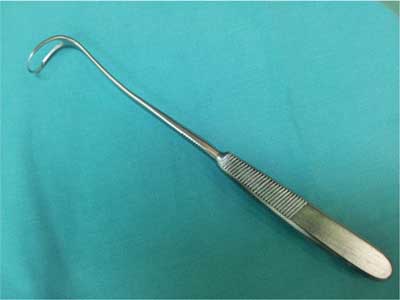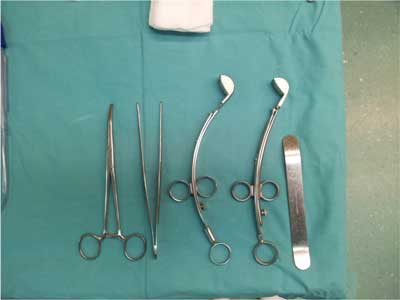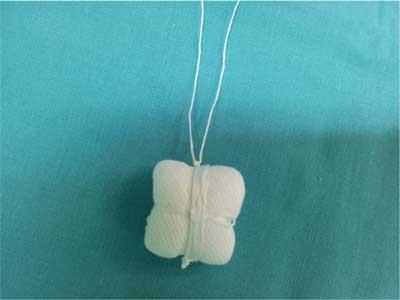© Borgis - New Medicine 4/2013, s. 123-125
Anna Gorzelnik, *Lidia Zawadzka-Głos
Bellocq’s tamponade in children who underwent operative treatment on the Waldeyer’s ring in the children’s otolaryngology clinic in Warsaw
Department of Pediatric Otolaryngology, Medical University of Warsaw, Poland
Head of Department: Lidia Zawadzka-Głos, MD, PhD
Summary
Aim. Surgical treatment of the adenoid and tonsils is counted as one of the most commonly performed operations in laryngology despite the possible postoperative complications. The main complications are bleedings. The failure in obtaining hemostasis is an indication to perform Bellocq’s tamponade.
Materials and methods. In the period between January 2008 and March 2012 in the Children’s Otolaryngology Clinic of Warsaw Medical University 1209 children have undercome surgical treatment of the Waldeyer’s ring. Hemorrhages due to surgery complications demanding the use of the Bellocq’s tamponade have been recorded in 25 children.
Results. Hemorrhages demanding the use of the Bellocq’s tamponade have occurred most often during the surgery or in post operation day zero. Additionally one fourth of the patients needed also blood-based products; mostly packed red blood cells. Eight patients required additional coagulation parameters analysis and a control visit at the hematologist. Two of them have been diagnosed with hemorrhagic diathesis for the first time.
Conclusion. All children, with hemorrhagic complications should be consulted by a hematologist.
INTRODUCTION
The adenoid and tonsils lymph tissue enlargement in children isn’t an inflammation symptom, but results from the body’s response to environmental antigens. Unfortunately often the tonsils and adenoid excessive overgrowth might cause obturation of the nasal part of the throat or the oropharyngeal isthmus, due to their location. The most serious symptom of the enlarged adenoid is obstructive sleep apnea.
The symptom mentioned above is an indication of adenoidectomy and tonsillectomy, despite the undesired immunological consequences and postoperative complications.
The main surgery complications are bleeding due to the failure in obtaining hemostasis, remains of adenoid tissue or inappropriate post operation care.
In case of perioperative or post-operative prolonging abundant bleedings, which might lead to blood products transfusion, where other methods to obtain hemostasis aren’t efficient, it is recommended to perform a Bellocq’s tamponade in order to compress the bleeding vessel. In such a situation the patient should be hospitalized, and prescribed antibiotics and painkillers. The tamponade should be removed not before 24 hours, slowly and gradually, while maintaining visual control of secondary bleeding. If it occurs a new tamponade should be introduced or a different hemostatic method should be considered.
MATERIAL AND METHODS
In the period between January 2008 and March 2012 in the Children’s Otolaryngology Clinic of Warsaw Medical University 1209 children have undergone surgical treatment of the Waldeyer’s ring.
Hemorrhages being complications of surgery, demanding the use of the Bellocq’s tamponade, have been stated in 25 children, including 12 girls and 13 boys. All the children had had coagulation parameters, i.e. activated partial thromboplastin time and prothrombin time tested normative prior to surgery. All children had been diagnosed with enlarged adenoid and 11 children with overgrown tonsils simultaneously. The patients’ age ranges between 3 and 16 years, with a mediana of 8.3 years.
Surgeries were performed using the classical method with a tonsils guillotine and Beckmann’s adenoid curette or La Force guillotine (fig. 1). In 11 children, both tonsillectomy and adenoidectomy have been performed, in 14 only the latter.

Fig. 1. Beckman’s adenoid curette.
In the described cases we tried to reach hemostasis through nasal tamponade for 5-7 minutes, compression with a hydrogen peroxide or Xylometazoline moistened swab for 1-3 minutes, tonsils point compression for 5-7 minutes or spot amphoteric coagulation. To treat the post-surgical bleedings antihemorragic medicines such as tranexamic acid (Exacyl) and etamsilate (Cyclonamine) or mucous vessels-obstructing medicines i.e. nasal xylometazoline or compression with a swab with a few drops of adrenaline, were used. Non-suppressible bleedings were an indication to introduce the Bellocq’s tamponade (fig. 2).

Fig. 2. La Force’a quillotine.
In 9 children due to unsatisfactory hemostasis it has been decided to introduce the Bellocq’s tamponade. In 16 cases the hemorrhage had place in the day zero post-operation, in 6 of them it occurred in the first hour during their stay in the monitoring room. In another 10 cases it happened in the next few hours back in the Otolaryngology Department. In 1 case the non-suppressible bleeding took place in day 1 post-operation.
In 4 cases it was decided to keep the patient with Bellocq’s tamponade in the post-surgery room in terms to monitor their life parameters. All the other children were taken back to the Otolaryngology Department.
All considered children received first intravenous and then consecutive oral antibiotics for an average of 8.35 days. 94% of them were prescribed tranexamic acid 20 mg/kg/day first intravenous and then oral for an average of 6.45 days and etamsilate 9 mg/kg/day first intravenous and next oral for an average of 7.5 days.
Two children received a transfusion of 1 unit of packed red blood cells (PRBC), 1 unit of cryoprecipitate and 1 unit of fresh frozen plasma (FFP). One child received 1 unit of packed red blood cells and 1 unit of fresh frozen plasma. Another 2 received only 1 unit of packed red blood cells. One child had only 1 unit of fresh frozen plasma. In the operated group 10 patients were O blood type, 12 were A type and 3 were B type.
The children had blood morphology analysis done before surgery and again during the hemorrhage. Hemoglobin ranged from 10.3 to 14.6 [g/dl] before the procedure and decreased of a medium of 3.22 during bleeding, red blood cells count [x 10\^6/uL] was 3.73 to 5.1 and decreased of 1.3. Packed cell volume varied between 30.0 and 42.9 before the operation to drop of 9.11 during it.
The hospitalization time ranged from 3 to 11 days, meaning the average stay in the hospital period was 6.75 days.
Eight patients required additional coagulation parameters analysis and a control visit at the hematologist. Two of them have been diagnosed with hemorrhagic diathesis for the first time. Another two children had results concerning one of the coagulation factors at the limit of being normative, which didn’t permit to diagnose hemorrhagic diathesis, but these patients demand hematologist’s control, especially in the case of excessive bruising, nose bleedings, prolonged bleeding after injury or tooth extraction. In 3 children basic or wider control coagulation parameters analyses were normative.
DISCUSSION
This paper results show that post-surgical hemorrhages demanding Bellocq’s tamponade introduction occurred in day 0 post-operation, most often during the procedure and in the first hour after then in the next 23 hours. It seems that bleeding taking place in the 2nd hour or later tends to respond better to pharmacological treatment. Additionally one fourth of the patients required blood product transfusion, packed red blood cells most often. This brings the idea of considering preparing packed red blood cell units and proceeding blood compatibility tests for patients getting the Bellocq’s tamponade.
Furthermore in patients with massive hemorrhages after tonsillectomy or adenoidectomy requiring Bellocq’s tamponade and blood products transfusion, despite normative coagulation basic analysis before the procedure and negative personal and family history in terms of hemorrhagic diathesis, it seems appropriate to start hematologic diagnosis including von Willebrand factor and factor VII analysis. In patients who did not require transfusions repeating basic coagulation parameters analysis should be considered in a later post-operation period.

Fig. 3. The Bellocq’s tamponade.
Table 1. Post-surgery treatment in children with enlarged adenoid implicated with Bellocq’s Tamponade.
| Patient | Age | Hospitalization period | Surgical procedure | Additional treatment* | Hematologic consult |
| B.M. | 8 | 9 | adenotonsillectomy | 1u. FFP | Edge level of von Willebrand
factor |
| P.M. | 6 | 6 | adenotonsillectomy | 1u. PRBC,
1u. FFP | Edge level of von Willebrand
factor |
| G.D. | 7 | 8 | adenoidectomy | 1u. PRBC,
1u. FFP,
2 u. Crioprecipitate | Factor VII deficiency,
hypofibrynogenemia |
| W.A. | 4 | 11 | adenotonsillectomy | 1u. PRBC,
1u. FFP,
2 u. Crioprecipitate | von Willebrand disease |
| J.W. | 6 | 5 | adenotonsillectomy | none | Prolonged activated
partial thromboplastin time |
| J.J. | 7 | 4 | adenoidectomy | none | Normative control basic
coagulation parameters |
| U.M. | 7 | 6 | adenotonsillectomy | none | Normative control wider
coagulation parameters |
| D.F. | 12 | 5 | adenoidectomy | none | Normative control basic
coagulation parameters |
CONCLUSION
Looking at these results, we conclude that serious adenoidectomy and tonsillectomy hemorrhagic complications implicating Bellocq’s tamponade occurred in 2% of all operated patients.
Most commonly the bleeding took place during the procedure or in day 0 post-surgery.
All children, who had hemorrhagic complications should have a hematological consultation.
Piśmiennictwo
1. Chmielik M, Zając B: Operacje migdałków podniebiennych i migdałka gardłowego u dzieci – metody operacyjne i wskazania do zabiegów. Magazyn Otolaryngologiczny 2003; 9, supl. 4. 2. Zwack GC, Derkay CS: The utility of preoperative hemostatic assessment in adenotonsillectomy. Int J Pediatr Otorhinolaryngol 1997; 39: 67-76. 3. Walocha J, Skawina A, Gorczyca J, Skrzat J: Anatomia prawidłowa człowieka. Szyja I głowa. Wydawnictwo Uniwersytetu Jagiellońskiego, Kraków 2003; 237-244. 4. Sawicki W: Histologia. PZWL, Warszawa 2009: 273. 5. Becker W, Naumann HH, Pfalz CR: Choroby uszu, nosa i gardła. Bel Corp, Warszawa 1999. 6. Dinis PB, Haider H, Gomes A: The effects of adenoid hypertrophy and subsequent adenoidectomy on paediatric nasal airway resistance. Am J Rhinol 1999; 13(5): 363-369. 7. Rasmussen N: Complications of tonsillectomy and adenoidectomy. Otolaryngol Clin North Am 1987; 20: 383-390. 8. Curtin J: The history of tonsil and adenoid surgery. Otolaryngol Clin North Am 1987; 20: 415-419. 9. Darrow D, Siemens Ch: Indications for tonsillectomy and adenoidectomy. Laryngoscope 2002; 112 (8 Pt 2 Suppl 100): 6-10. 10. Raut V, Bhat N, Kinsella J: Bipolar scissors versus cold dissection tonsillectomy: a prospective, randomized, multi-unit study. Laryngoscope 2001; 111: 2178-2182. 11. Bochenek A, Reicher M: Anatomia człowieka. PZWL, Warszawa 2010. 12. Behrbohm H, Kaschke O, Nawka T, Swift A: Choroby ucha, nosa i gardła z chirurgią głowy i szyi. Elsevier Urban & Partner, Wrocław 2011.


